Insect Control Service for Lawns
Common Insects of Colorado That Can Damage Lawns
Most Common Lawn Insects in Colorado – Spider Mites and Grubs
Spider Mites and lawn grubs are the two most damaging insects to Colorado lawns, but the vast majority of insect causing lawn damage can be prevented or treated without the use of insecticides or chemicals. The key to effective lawn pest control lies in watering according to the 1-2-3-2-1 lawn watering technique.
How Proper Lawn Watering Can Kill Grub Eggs
An example of how this works involves grub eggs. Grubs lay their eggs in moist soil, and if the soil dries out for as little as 24 hours, the eggs will die and become unviable. The 1-2-3-2-1 lawn watering technique incorporates two consecutive days in July when the lawn is not watered. This timing coincides with when grubs are laying their eggs. This watering technique is based on logic and science, and those two consecutive days without watering are crucial for protecting the lawn from grub pressure, as they will kill the grub eggs.
Insects That Can Attack Colorado Lawns
Billbugs
Billbugs are a Type of Weevil
Billbugs are a type of weevil, also known as “snout beetles.” Adult weevils are typically seen on driveways and pavement from late spring through late summer. While adults can cause minor damage to lawns by creating small holes in the stems of plants to lay their eggs, the primary damage to lawns is caused by billbug grubs.
Description
Billbug grubs are white or cream-colored with brown heads and can grow to be 1/3 to 1/2 inch long when fully developed. Young grubs feed in the crown area of the grass, which can lead to the death of the turf. Signs of grub damage are evident when the grass lifts easily from the ground, resembling a freshly laid piece of sod. Older grubs feed lower down in the crown and in the plant root zone, producing small piles of sawdust-like material during this feeding stage.
Damage
Billbug injury is most common in lawns with shallow root structures. Most damage occurs near evergreen shrubbery such as juniper bushes, spruce, or pine trees. The symptoms of billbug damage include wilting and sporadic patches of dead grass, which can expand significantly during severe infestations.
Prevention
Preventing billbug damage is straightforward. Lawns with deep-rooted grass can better withstand billbug pressure. Implementing the 1-2-3-2-1 lawn watering technique helps encourage deep-root growth. Additionally, annual core aeration and using high-quality organic fertilizers can further promote the health of grass roots. Insecticides should only be used in extreme cases of billbug infestation.
Billbugs
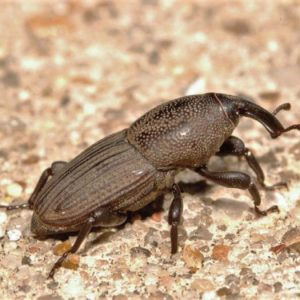
Cinch Bug
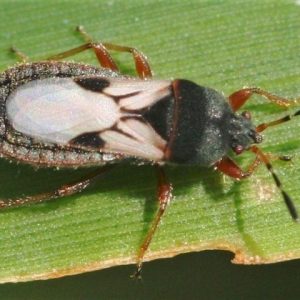
Chinch Bugs
Not Common in Colorado
Chinch bugs are relatively uncommon in Colorado. While there have been reports of localized infestations in some lawns in the Denver area, they are not a widespread issue in Boulder or Fort Collins. The specific chinch bug species identified in Colorado’s turfgrass is the hairy chinch bug.
Damage
Chinch bugs can damage lawns by feeding on grasses. Various species of chinch bugs are known to harm turfgrass in different areas of the United States. Their feeding can lead to wilting and, in some cases, death of the plants. Outbreaks of chinch bugs are typically associated with hot, dry weather, and proper irrigation can help suppress these pests.
Prevention
Since chinch bugs do not pose a significant threat in Colorado, we do not recommend treating for them. However, following the 1-2-3-2-1 lawn watering technique can be very effective in managing chinch bug outbreaks if they happen to occur.
Cranberry Girdler
Commonly Found in Colorado Lawns
Cranberry girdler grubs are found throughout the United States and can be particularly damaging to lawns. The larvae prefer cool-season grasses, such as Kentucky bluegrass, bentgrass, and fine-leaf fescues. In addition to inflicting significant damage to turfgrass, they are also known to be pests of cranberry plants, Douglas fir trees, and true fir trees. Cranberry girdlers can move from infested grasslands to trees.
Identification
While cranberry girdler eggs and pupae can easily be mistaken for other sod webworms found in turfgrass, the larvae and adult insects are distinctive. Heavy infestations can kill turf grass as the larvae feed on the roots. Symptoms of damage typically resemble the effects of white grubs, where the sod becomes loosely attached to the soil. The first signs of turf grass injury appear as small brown patches in late summer when the larvae are nearing maturity. Extensive infestations can quickly lead to greater damage, creating large dead areas of sod by early fall.
Prevention
To prevent cranberry girdler infestations, it is essential to water the lawn using the 1-2-3-2-1 lawn watering technique. This method works because the adults lay their eggs in lawns during July, specifically in areas with wet soil. By following the 1-2-3-2-1 watering principles, the soil will completely dry out between watering sessions, making it inhospitable for egg-laying.
Treatment if Necessary
If it is too late to properly water the lawn to avoid an infestation and a problem does occur, we recommend applying a specialized insecticide called Acelepryn. If your lawn is being attacked by cranberry girdlers, contact our office to schedule your insecticide application today.
To schedule an application of Acelepryn please contact us today. 303-499-2000
Cranberry Girdler
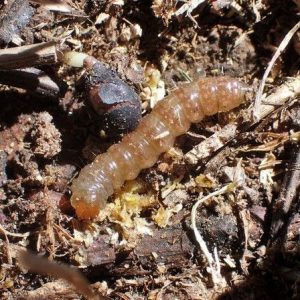
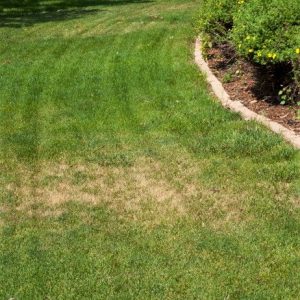
Dry Lawn or Drought Stress
Commonly Misdiagnosed as an Insect Problem
Drought stress is not caused by insects, but it is the primary reason for brown lawns in Colorado. One of the biggest lawn care issues in the state is improperly adjusted sprinkler heads that miss areas of the lawn. Approximately 90% of the brown spots found in lawns are due to poor sprinkler coverage or incorrect watering techniques.
June, July, and August
The worst brown spots typically appear during the hot summer months of June, July, and August, as well as during extended drought periods. Many homeowners mistakenly believe that a brown spot indicates a disease or insect issue; however, in most cases, the problem stems from sprinkler heads that are misaligned, blocked by plants, or malfunctioning.
Treatment
Recovering a brown spot caused by inadequate sprinkler coverage is relatively straightforward. Begin by adjusting or fixing the sprinkler head issue, then water the affected area for three consecutive days. It’s also important to ensure that the lawn is being watered correctly according to the 1-2-3-2-1 watering technique. If adjustments to the sprinkler heads do not allow for proper watering, consider using a hose and sprinkler head for hand watering to address the dry spot.
Leafhoppers in Grass
Common but Not Very Damaging to Lawns
Leafhoppers are common insects found in lawns. These small insects typically measure less than 1/6 inch in size. Their color can vary, but many of the more commonly encountered species in turfgrass are generally light-colored or light brown.
Identification
Adults are usually only noticed when a person walks across the lawn or mows the grass, as these activities can disturb the insects and cause them to fly or jump off the blades of grass.
Feeding
Leafhoppers feed by sucking sap from the grass blades. Generally, their feeding results in little visible damage, with the most noticeable effect being small whitish spots on the leaves. However, the overall damage is minimal.
Control and Prevention
Controlling leafhoppers is often difficult to justify, as they cause very little harm to the lawn. Nonetheless, they can be a nuisance and attract attention. The use of insecticides to manage leafhoppers is not warranted when considering the lawn’s health. To prevent major infestations, it is best to water the lawn using the 1-2-3-2-1 lawn watering technique.
Leafhoppers


Mites – a.k.a. Lawn Mites, Banks Grass Mites, Clover Mites or Spider Mites
Major Problem During Dry Winters
Grass mites can pose significant problems for lawns during hot and dry winter months. These tiny insects are nearly impossible to see with the naked eye and can come in various colors; however, during dry periods, especially indoors, they are often a brick-red color. Grass mites feed on the roots and blades of grass using their rasping-sucking mouthparts, and in severe infestations, they can dry out the grass to the point of death.
Identification
These mites are typically found on the south-facing sides of buildings, in rock beds, on sun-exposed slopes, and around pine trees. Grass mites usually feed on grass from November to March during warm and dry weather and seek shelter in pine trees and buildings during cold and wet conditions.
Control and Prevention
Controlling grass mites is straightforward. Since they dislike water, one effective way to prevent spider mite damage is to water the lawn during prolonged droughts, particularly in the winter months. Watering the lawn will discourage mites from feeding and provide the grass with the moisture it needs to prevent drying out. Lawns that follow the 1-2-3-2-1 watering technique will develop deep-root systems, making them less susceptible to damage from grass mites.
Treatment if Necessary
If watering isn’t a feasible option, grass mites can be effectively controlled with an organic insecticide called Ecotrol. In Colorado, lawn mites are a common issue during extended warm spells in the winter.
Sod Webworm
Common in Colorado but Not Usually Problematic
Sod webworms are one of the most common lawn insects found in Colorado. While adult moths do not feed on the grass, female moths lay eggs that hatch into small caterpillars.
Identification
Sod webworm larvae are about ¼ to 1 inch long and are brown or gray in color, featuring rows of dark spots on their backs. During the day, young webworms reside in silk-lined tunnels in lawns that have thatch or at the soil’s surface. At night, they emerge from these tunnels to feed on grass leaves.
Treatment and Prevention
Although sod webworms are commonly found in lawns, healthy and robust grass can withstand the damage they cause without affecting the lawn’s appearance. Proper lawn care, including regular applications of organic fertilizer and watering according to the 1-2-3-2-1 technique, will help maintain a lawn’s health, allowing it to endure substantial webworm populations. Additionally, birds that feed on the larvae can help prevent visible damage to the turf.
To schedule an application of Acelepryn please contact us today. 303-499-2000
Sod Webworm
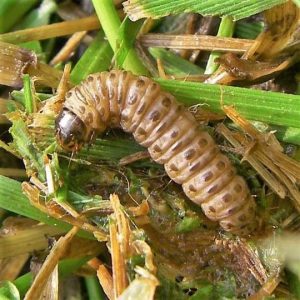
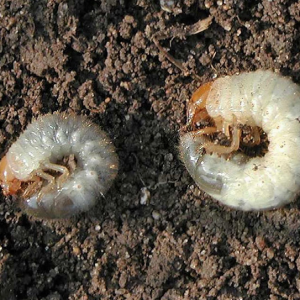
White Grubs – Japanese Beetle Grubs
Very Problematic in Colorado
Due to irrigation practices, white grubs are becoming a significant problem for lawns in Colorado. These grubs feed on grass roots, leading to large brown spots in the turf. The damaged areas can often be lifted from the soil, similar to how freshly laid sod would behave.
Identification
Most lawns contain a few white grubs without showing any visible damage. However, when their populations become high, they can kill large sections of turf. Additionally, the presence of grubs—even with minimal turf damage—can be indicated by foraging raccoons and skunks, which may dig up large patches of lawn overnight in search of this favored food.
Control and Prevention
To control white grubs, it’s effective to allow the soil to dry out during July. Grubs tend to lay their eggs only in moist or wet soil. Lawns following the 1-2-3-2-1 watering technique are less likely to be attacked by grubs, because the soil dries out completely between watering cycles.
Treatment When Necessary
By the time the damage becomes noticeable, the grubs are often large, making them more difficult to eliminate without the use of insecticides. During periods of grub activity, applying a specialized insecticide called Acelepryn is highly effective in controlling them.
To schedule an application of Acelepryn please contact us today. 303-499-2000
Why is Lawn Watering the Most Effective Way to Prevent Lawn Insects?
Learn About the 1-2-3-2-1 Lawn Watering Technique
Control the Environment
Perhaps you didn’t realize that almost all lawn insects in Colorado can be prevented by following the 1-2-3-2-1 lawn watering technique. Most lawn insects thrive in lawns that suffer from improper care, such as poor irrigation practices or mowing the grass too short.
Address the Cause of the Problem
If your lawn is experiencing insect issues, we will develop a plan that first addresses the root cause before tackling the insect problem. Our long-term solution typically involves making some simple but crucial adjustments, such as changing the mowing height and modifying the watering schedule. We only resort to using insecticides as a last measure, as they are often unnecessary.
Identification Before Treatment
Before applying any insecticide to your lawn, please contact our office to schedule a consultation with one of our professional lawn care technicians, who will perform a thorough diagnosis. There is a fee for this service; however, we will waive all or part of the fee if you choose to implement our recommendations to resolve the lawn care issue. Remember, the first step in fixing a grass problem is accurately diagnosing the underlying cause.
Proper Lawn Watering Prevents Insect Pressure
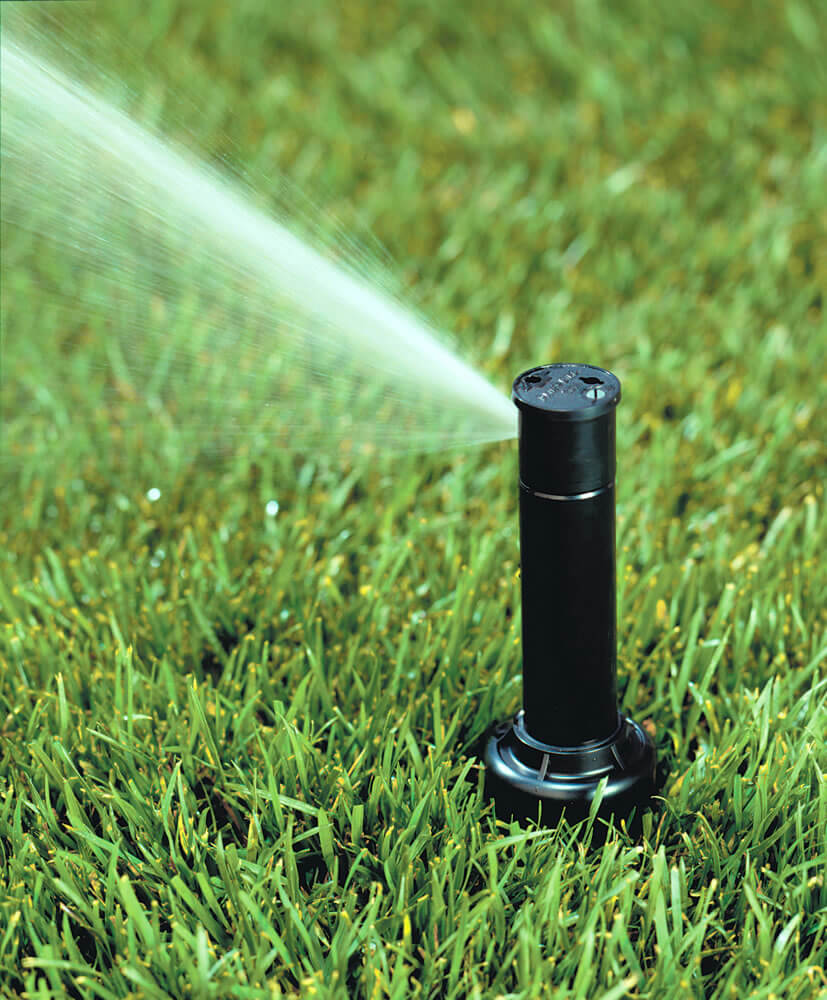
Need Help With a Lawn Insect Problem?
<b (303) 499-2000 Boulder
(970) 225-9425 Fort Collins.
Insect Control Service for Lawns of Colorado FAQs
Which Insects Cause the Most Damage to Colorado Lawns?
Spider Mites
In Colorado, two insects are particularly harmful to lawns. Firstly, the Banks Grass Mite, also known as the spider mite, causes significant damage during the winter months. These mites suck moisture from the grass, especially during prolonged warm and dry spells. Lawns that face south and have shallow grass roots are particularly susceptible to this damage.
Grubs
Secondly, white grubs from the Japanese beetle are responsible for the most lawn damage in Colorado during September and October. These grubs feed on the roots of grass, leading to large patches of dead or brown turf. The damaged areas can often be lifted easily from the soil, much like freshly laid sod.
How Prevent Insects in Lawns Without Using Chemicals?
Following the 1-2-3-2-1 lawn watering recommendations is one of the most important steps to preventing insect pressure in lawns. Improper lawn watering practices are the main cause of 99% of lawn insect pressures. The most effective defense to infestations is to maintain proper lawn care cultural practices, such as proper lawn mowing techniques, the use of organic lawn fertilizers instead of chemical lawn fertilizers, proper lawn watering (deep and infrequent watering), core aeration, and avoiding the use of chemicals.